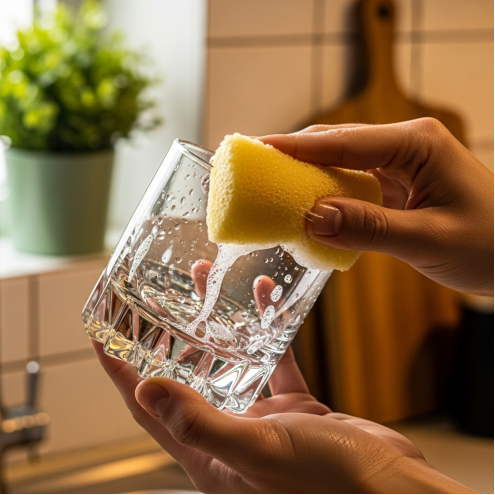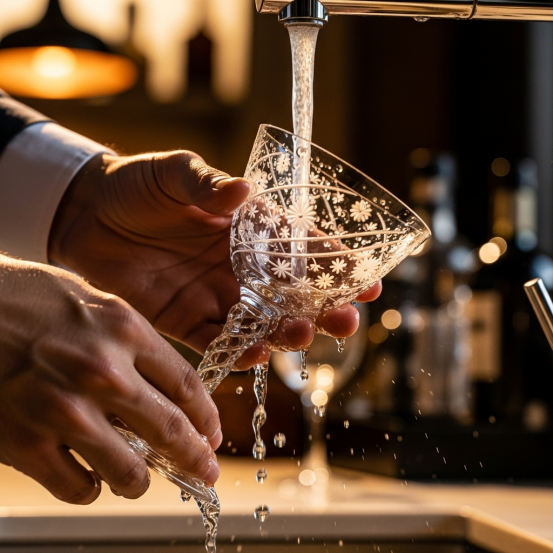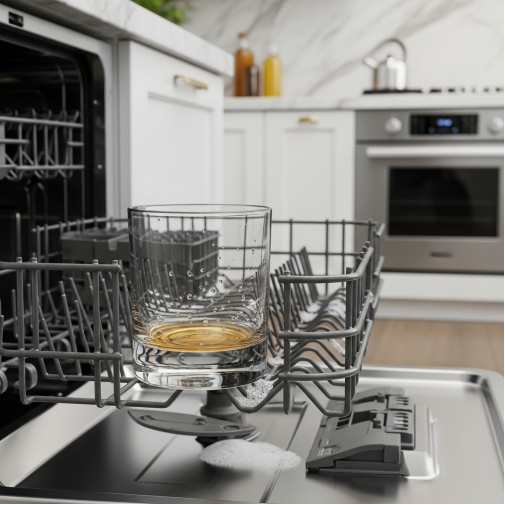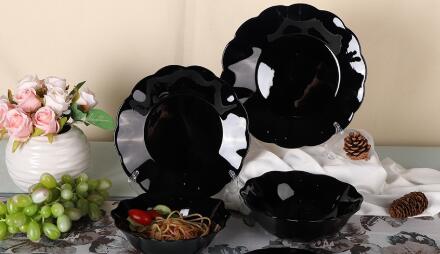Glass Cleaning and Maintenance Guide to Make Your Crystal Sparkle Like New
Pulished on Sep. 02, 2025It's common that we face the situation when our favorite glass cups become dirty and hard to clean. This passage will show you how to make your treasure to turn out to sparkle like diamond again. Some people might wash glasses by hand, some might by dishwasher. Let’s check the difference between them and what we should notice when washing the delicate glass cups.

1. Glass cup hand washing tips
Hand washing is the most recommended method for cleaning glass cups, especially for delicate, expensive ones because it’s the most gentle and controllable way for glassware.
Core Techniques & Steps:
1) Use a plastic basin or mat:
To prevent accidental chips or cracks, avoid washing directly in a hard ceramic or metal sink. Place a plastic wash basin or a silicone mat in the sink to create a soft cushion.
2) Prepare lukewarm water and mild detergent:
Fill the basin with lukewarm water. Avoid extreme temperatures (too hot or too cold), as sudden temperature changes can cause the glass to break. Add just a few drops of a mild, unscented dish soap. Do not scrub too hard on the glasses.
3) Wash one glass at a time:
Do not overcrowd the sink. Washing multiple glass cups at once is a common cause of breakage from underwater collisions. Follow a "one in, one out" policy.
4) Use a dedicated soft cloth or sponge:
Use a clean sponge or microfiber cloth reserved only for glassware to avoid transferring grease or food particles. Never use abrasive scouring pads or steel wool.
5) Focus on the rim and base:
Hold the bowl of the glass firmly and carefully clean the rim (where lips touch) and the base, as these areas accumulate the most residue. For tall, narrow glasses, use a bottle brush with a soft tip.
6) Hold the bowl, not the stem:
When washing a stemmed glass, hold the bowl securely. Applying pressure to the bowl while holding the stem or foot can easily cause the delicate stem to snap.
7) Rinse thoroughly:
Rinse the glass completely under a gentle stream of lukewarm running water to remove all soap residue.
8) Dry immediately to prevent water spots:
This is the most critical step for a sparkling, crystal-clear finish. Use two clean, lint-free microfiber or linen cloths. Hold the bowl of the glass with one cloth (to avoid fingerprints) and gently polish the inside and outside with the other.

2. How to remove cloudiness from glass cups
After using for a long time, glass cups can become cloudy. This "white mist" is usually caused by mineral deposits from hard water. While white vinegar is a natural miracle worker for removing this mineral.
Steps:
1) White vinegar soak:
Completely submerge the cloudy glass cups in white vinegar.
2) Soak the glass :
Let the cups soak for at least 30 minutes. For stubborn film, you can soak them for several hours.
3) Gently scrub:
After soaking, the film can be easily removed by gently wiping with a soft cloth or sponge.
Rinse and dry: Rinse thoroughly with clean water to remove the vinegar smell, then dry.
3. How to remove tea or coffee stain from glass cups
Tannins in tea and coffee are the culprits behind stubborn stains. Baking soda is an effective and safe way to remove these stains. If you don’t have soda, you can also try the plastic bag with toothpaste.
Steps (Baking Soda Method):
1) Make a baking soda paste:
Put a tablespoon of baking soda in the cup and add a small amount of water to mix into a paste.
2) Apply and scrub:
Spread the paste evenly on the stain and gently scrub with a soft cloth or your fingers.
3) Let it sit:
For stubborn stains, let the baking soda paste sit for 15-30 minutes.
4) Rinse thoroughly:
Rinse the baking soda and stains thoroughly with warm water.
4. Glass cup dishwasher cleaning
Using a dishwasher is convenient, but proper technique is essential to prevent your beloved glassware from cloudiness, etching, or breakage.

Core Techniques & Steps:
1) Load dishwasher-safe glasses only:
Check the bottom of the glass or the manufacturer's instructions. Hand-painted glasses, items with metallic rims (gold or silver), and delicate crystal should almost always be hand-washed.
2) Rinse off solids, but don't pre-wash:
Scrape or rinse away any solid debris like tea leaves. However, glasses don't need to be perfectly clean; some soil helps the detergent work more effectively.
3) Place securely on the top rack:
The top rack of a dishwasher receives a gentler spray and lower temperatures, making it the safest place for glassware. Place glasses upside down, ensuring they are not touching each other or any other dishes to prevent rattling and chipping.
4) Use the right amount of quality detergent and a rinse aid:
Using too much detergent is a primary cause of "etching"—a permanent cloudiness caused by chemical corrosion. Always use a rinse aid. It helps water sheet off the glasses, dramatically reducing water spots and improving drying.
5) Select a gentle cycle:
If your dishwasher has a "Delicate," "Glassware," or "China" setting, use it. Otherwise, choose a normal or eco-cycle with a low-temperature setting. Avoid heavy-duty or "Pots and Pans" cycles.
6) Skip the heated dry cycle:
High-heat drying can bake mineral deposits from hard water onto the the glass, creating stubborn spots. Instead, select an air-dry setting or stop the dishwasher before the heated dry cycle begins.
7) Open the door immediately after the cycle finishes:
As soon as the wash cycle is complete, open the dishwasher door to let the steam escape. This prevents water vapor from settling on your glasses and leaving spots. Allow the glasses to cool for a few minutes before handling them.
In conclusion, it is not easy to protect the glassware when washing and cleaning. But when after finishing washing work, seeing all the sparkle lights from your lovely glass cups, you will think all of work deserve at that time.









